WEEK 1: THE SOVIET PLAN TO DESTROY GUANTANAMO (Posted June 4, 2008)
WEEK 2: MISSING OVER THE SOVIET UNION (Posted June 11, 2008)
WEEK 3: TRACING THE NUCLEAR WARHEADS (Posted June 18, 2008)
WEEK 5: THE "EYEBALL TO EYEBALL" MYTH (Posted July 2, 2008)
ABOUT THIS SERIES
When Washington Post reporter Michael Dobbs first decided to write a book about the Cuban missile crisis, the question he was most frequently asked was, “What is there new to say about a subject that has been so exhaustively studied?” The answer, it turned out, was “a great deal.” Two years of research in half a dozen countries, including the United States, Russia, and Cuba, turned up a surprising amount of new information about the thirteen days in October 1962 when the world had its closest brush with nuclear destruction. His minute-by-minute narrative also explodes some long-accepted myths, repeated for decades by missile crisis scholars.
Over the next five weeks, the National Security Archive will publish some of the key primary sources behind One Minute to Midnight: Kennedy, Khrushchev and Castro on the Brink of Nuclear War. The new information includes such episodes as a startling Soviet plan to destroy the Guantanamo naval base, the storage and handling of Soviet nuclear weapons on Cuba, and the “Eyeball to Eyeball” confrontation between U.S. and Soviet ships that never happened.
The revelations in One Minute to Midnight shed new light on presidential decision-making at moments of supreme tension. Some of the information that flowed into the Oval Office during the crisis was erroneous. U.S. intelligence analysts seriously under-estimated the number of Soviet military personnel in Cuba and failed to identify the bunkers for Soviet nuclear warheads, despite possessing photographic evidence that is being published for the first time in One Minute to Midnight. Soviet and U.S. leaders consistently misinterpreted each other’s signals.
American scholars have traditionally treated the Cuban missile crisis as a case study in the art of crisis management. The historian Arthur Schlesinger, Jr. praised Kennedy’s “brilliantly controlled…matchlessly calibrated” handling of the Soviets. The new revelations suggest that the crisis is better understood as an example of the limits of crisis management and presidential power. As told by Dobbs, the missile crisis is a case study of “government by exhaustion” in which frazzled policy-makers struggle to master the chaotic forces of history that they themselves helped to unleash. |

The Cuban Missile Crisis, 1962
The 40th Anniversary
Docments, photos, audio clips and more from the historic 40th anniversary conference in Havana
|
THIS WEEK: THE SHOOTDOWN OF MAJOR ANDERSON
Washington, DC, June 25, 2008 - American signals intelligence collectors tracked the activation of Soviet air defenses prior to the shootdown of a U.S. spy plane at the peak of the Cuban missile crisis, according to documents published on the Web today by the National Security Archive.
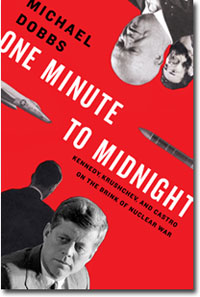 A new book by Washington Post reporter Michael Dobbs shows that the destruction of the U-2 piloted by Major Rudolf Anderson, Jr. on October 27, 1962, was closely connected to the deployment of Soviet nuclear cruise missiles in the vicinity of the U.S. naval base at Guantanamo. Soviet generals feared that the spy plane had uncovered the forward launch position of the cruise missiles, just 15 miles from Guantanamo. A new book by Washington Post reporter Michael Dobbs shows that the destruction of the U-2 piloted by Major Rudolf Anderson, Jr. on October 27, 1962, was closely connected to the deployment of Soviet nuclear cruise missiles in the vicinity of the U.S. naval base at Guantanamo. Soviet generals feared that the spy plane had uncovered the forward launch position of the cruise missiles, just 15 miles from Guantanamo.
This is the fourth of five postings looking at the new material in One Minute to Midnight: Kennedy, Khrushchev, and Castro on the Brink of Nuclear War, which draws on the National Security Archive's long-standing documentary work on the Cuban missile crisis. The book provides new details about U.S. SIGINT (signals intelligence) activities in and around Cuba at the height of the missile crisis.
A great deal of attention has been paid to the role of photographic intelligence in discovering the Soviet missile sites in Cuba in October 1962, leading to what became known as the Cuban missile crisis. There has been much less focus on the important role played by signals intelligence and radar intelligence on the part of the hyper-secretive National Security Agency, which provided U.S. policymakers with real-time information about the status of various Soviet weapons systems.
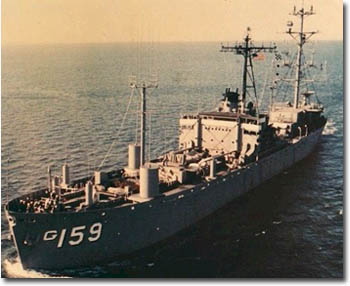 |
The USS Oxford conducted signals intelligence operations off the coast of Cuba |
SIGINT collectors in and around Cuba during the crisis included the USS Oxford, a converted World War II Liberty ship stationed off Havana, and RB-47 electronic reconnaissance planes belonging to the 55th Strategic Reconnaissance Wing, which flew constantly around the periphery of the island. Intelligence officers aboard both platforms were able to monitor the radar systems associated with Soviet weaponry in real time, and report when they were activated, a key sign that they were ready to fire.
By October 27, the virtually unarmed Oxford had been pulled back to the middle of the Florida Strait, because of fears that it might come under attack by the Cubans and their Soviet allies. Stationed 80-90 miles from Havana, it lost the ability to monitor microwave telephone conversations, but was still able to collect radar signals from the surface-to-air missile (SAM) sites deployed along the Cuban coastline. Activation of the “Spoon Rest” target acquisition radar associated with the SAM sites was a clear sign that the Soviets were preparing to shoot down U.S. reconnaissance planes flying over Cuba.
A declassified NSA document and interviews with former intelligence gatherers shows that the Oxford picked up “Spoon Rest” signals from the Havana area shortly after midnight on October 27. The radar system remained active for the rest of the day. One Minute to Midnight reports that Fidel Castro had visited the Soviet headquarters at El Chico the previous evening and persuaded Soviet generals to switch on their air defense radars, arguing that they could not “remain blind” in the face of an expected U.S. attack.
Despite the new intelligence on the imminent threat to the U-2 spy planes, the U.S. Strategic Air Command (SAC) decided to proceed with a mission over eastern Cuba by Maj. Rudolf Anderson. A U.S. Navy document shows that three other U-2 missions planned for October 27 were scrubbed at the last moment, but the Anderson mission (Mission 3128) went ahead.
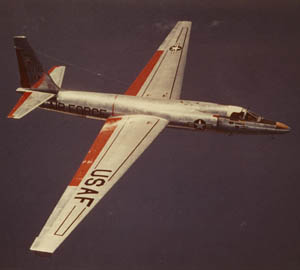 |
The U-2 spy plane |
|
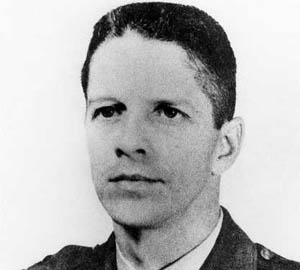 |
U.S. Air Force Maj. Rudolf Anderson |
|
The appearance of a U-2 over eastern Cuba alarmed Soviet generals as it coincided with the movement of a Soviet cruise missile unit to the vicinity of the Guantanamo naval base, as described in a previous post. The deputy commander of Soviet forces on Cuba, Gen. Leonid Garbuz, has described how he took the decision to shoot down the U-2 in conjunction with the commander of Soviet anti-aircraft forces, Gen. Stepan Grechko. As Garbuz recalled the scene in the combat center of Soviet military headquarters at El Chico:
| I expressed the view that all our missile starting positions had been uncovered, and we must not allow that the secret information to fall into the hands of the Pentagon. Stepan Naumovich several times tried to get in touch with our commander [Gen. Issa Pliyev] but we did not succeed in finding him in the crucial minutes. It was also impossible to get in touch with Moscow in such a short time. We knew that Pliyev had more than once asked [Defense minister] Malinovsky to allow him to shoot down American spy planes, but had received no answer. After a short period of reflection, S.N. Grechko announced, "Well, let’s take responsibility ourselves." |
The order was transmitted to Soviet air defense headquarters in the town of Camaguey in central Cuba. Click here for an interview with the regiment’s former political officer, Colonel Grigory Danilevich, describing the tracking of Anderson’s U-2 and the order to shoot the plane down. From Camaguey, the order was transmitted to a SAM missile site near the town of Banes in Oriente province. U.S. Air Force planes had overflown the Banes site the previous day, on October 26, and taken photographs of the SAM missiles in their launching positions.
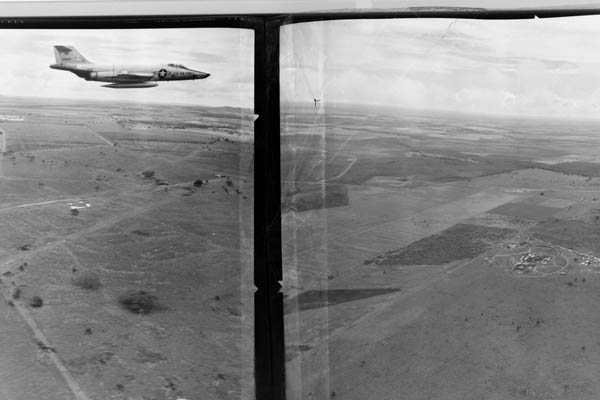 |
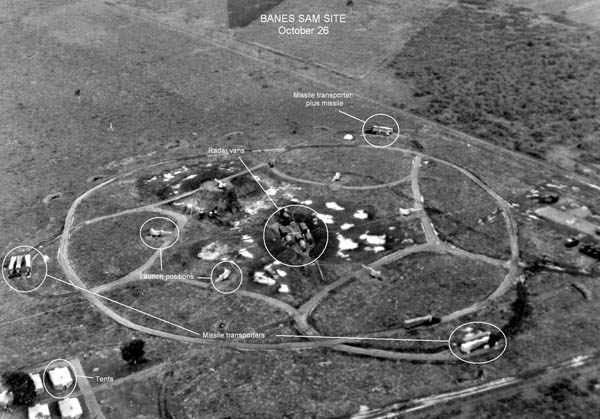 |
U.S. Air Force reconnaissance planes overflew the Banes site on October 26, 1962, and photographed Soviet SAM missiles in launching position. |
A declassified CIA document shows that Anderson overflew the town of Camaguey and advance Soviet nuclear cruise missile positions in the village of Filipinas, west of Guantanamo. The Soviet generals took the decision to shoot down his U-2 shortly after he overflew Guantanamo, and turned in a northwesterly direction back toward Florida.
Click on map icons for more information (View Larger Map)
At least one U.S. RB-47 spy plane was in the air, circling Cuba, at the time Anderson flew over the island. A declassified history of 55th Strategic Reconnaissance Wing reports that pilots picked up several “Big Cigar” or “Fruit Set” fire control radars on the morning of October 27. Activation of the “Fruit Set” radar meant that the Soviets were actively attempting to shoot down a hostile plane. The RB-47 reported interception of the radar signals to Washington but had no means of alerting Anderson of the imminent danger of a shootdown. The interception of the radar signals was promptly reported to Defense secretary Robert McNamara who informed President Kennedy about the activation of a “Fruit Cake” radar. (He meant “Fruit Set.”)
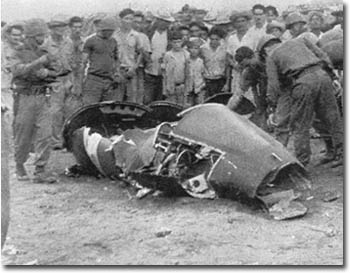 |
Wreckage of Maj. Anderson's U-2 plane |
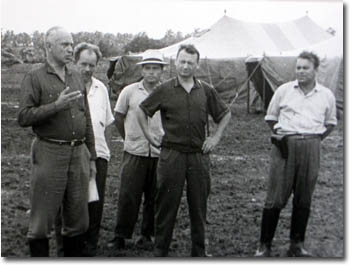 |
Soviet Col. Georgi Voronkov (left) congratulated his men on the shootdown of the U-2. |
Wreckage from the Anderson plane landed in the village of Veguitas, near Banes. Anderson’s body was discovered in the cockpit of the plane, as reported by a CIA informer. On October 28, the commander of the Soviet Air Defense unit, Colonel Georgi Voronkov, personally congratulated his men on the shootdown of the U-2. The Soviet soldiers are dressed in civilian clothes as part of the camouflage effort. (Voronkov is on the left; Danilevich is in center in the black shirt; the commander of the Banes SAM site, Major Ivan Gerchenov, is on the right, with a pistol in his belt.)
More information on the shootdown of Major Anderson, including the full story of his final mission and U.S. SIGINT activities in Cuba, is available in One Minute to Midnight, available through Amazon.com.
If you have Google Earth installed on your computer, you can track U.S. intelligence gathering efforts by downloading this file and opening it in the free Google Earth application.
 Open the 'anderson_shootdown' KMZ file in Google Earth Open the 'anderson_shootdown' KMZ file in Google Earth
If you do not currently have Google Earth installed on your computer, you can access this information by taking the following steps:
If you do not currently have Google Earth installed on your computer, you can access this information by taking the following steps:
1. Download and install the free Google Earth application.
2. Download the Google Earth file on the Anderson shootdown and open the file using the Google Earth application.
NEXT WEEK: THE "EYEBALL TO EYEBALL" MYTH (Coming July 2, 2008)
WEEK 1: THE SOVIET PLAN TO DESTROY GUANTANAMO (Posted June 4, 2008)
WEEK 2: MISSING OVER THE SOVIET UNION (Posted June 11, 2008)
WEEK 3: TRACING THE NUCLEAR WARHEADS (Posted June 18, 2008)
WEEK 5: THE "EYEBALL TO EYEBALL" MYTH (Posted July 2, 2008)
|

